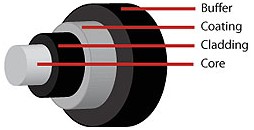Nov 29, 2016
Normally when we compare Single Mode and Multi-mode Fiber Optic Patch Cords, We have to make clear about what is the difference of Single mode and Multi-mode fiber, now let’s get down to below definitions:
Single Mode
Single Mode cable is a single stand of glass fiber with a diameter of 8.3 to 10 microns that has one mode of transmission. Single Mode Fiber with a relatively narrow diameter, through which only one mode will propagate typically 1310 or 1550nm. Carries higher bandwidth than multimode fiber, but requires a light source with a narrow spectral width. Synonyms are mono-mode optical fiber, Single-Mode Fiber, single-mode optical waveguide, uni-mode fiber.
Single-mode fiber gives you a higher transmission rate and up to 50 times more distance than multimode, but it also costs more. Single-mode fiber has a much smaller core than multimode. The small core and single light-wave virtually eliminate any distortion that could result from overlapping light pulses, providing the least signal attenuation and the highest transmission speeds of any fiber cable type.
Single-mode optical fiber is an optical fiber in which only the lowest order bound mode can propagate at the wavelength of interest typically 1300 to 1320nm.
Multi-Mode
Multimode cable is made of glass fibers, with common diameters in the 50-to-100 micron range for the light carry component (the most common size is 62.5). POF is a newer plastic-based cable which promises performance similar to glass cable on very short runs, but at a lower cost.
Multimode fiber gives you high bandwidth at high speeds over medium distances. Light waves are dispersed into numerous paths, or modes, as they travel through the cable's core typically 850 or 1300nm. Typical Multimode Fiber Optic Trunk Cable core diameters are 50, 62.5, and 100 micrometers. However, in long cable runs (greater than 3000 feet [914.4 ml), multiple paths of light can cause signal distortion at the receiving end, resulting in an unclear and incomplete data transmission.
What is the difference between multimode and single mode fiber?
Multimode fiber has a relatively large light carrying core, usually 62.5 microns or larger in diameter. It is usually used for short distance transmissions with LED based fiber optic equipment. Single-mode fiber has a small light carrying core of 8 to 10 microns in diameter. It is normally used for long distance transmissions with laser diode based fiber optic transmission equipment.
Now let’s go to the patch cords: Single mode and Multi-mode fiber optic patch cables – or jumper cables
Firstly let’s get down to the core of the matter:
 Of course, it’s the core of fiber cables that carries the light to transmit data – and the main difference between Single mode and Multi-mode fiber patch cables is the size of their respective cores.
Of course, it’s the core of fiber cables that carries the light to transmit data – and the main difference between Single mode and Multi-mode fiber patch cables is the size of their respective cores.
Single mode cables have a core of 8 to 10 microns. In single mode cables, light travels toward the center of the core in a single wavelength. This focusing of light allows the signal to travel over longer distances without a loss of signal quality than is possible with Multi-mode cabling. Most Single mode cabling is color-coded yellow.
Multi-mode cables have a core of either 50 or 62.5 microns. In Multi-mode cables, the larger core gathers more light compared to Single mode, and this light reflects off the core and allows more signals to be transmitted. Although more cost-effective than Single mode, Multi-mode cabling does not maintain signal quality over long distances. Multimode cables are generally color-coded orange or aqua; the Aqua Fiber Patch Cables are for higher performance 10Gbps, 40Gbps, and 100Gbps Ethernet and fiber channel applications.
See all of the Singlemode and Multi-mode Fiber Optic Patch Cables
While you’re at it, check out our Pigtails
Q: Which is better? A: It depends on your application:
 Single mode Fiber Patch Cables are the best choice for transmitting data over long distances. They are usually used for connections over large areas, such as college campuses and remote offices. They have a higher bandwidth than Multi-mode cables to deliver up to twice the throughput.
Single mode Fiber Patch Cables are the best choice for transmitting data over long distances. They are usually used for connections over large areas, such as college campuses and remote offices. They have a higher bandwidth than Multi-mode cables to deliver up to twice the throughput.
 Multimode Fiber Patch Cables are a good choice for transmitting data and voice signals over shorter distances. They are typically used for data and audio/visual applications in local-area networks and connections within buildings or remote office in close proximity to one another.
Multimode Fiber Patch Cables are a good choice for transmitting data and voice signals over shorter distances. They are typically used for data and audio/visual applications in local-area networks and connections within buildings or remote office in close proximity to one another.
Conclusion:
Use Multi-mode to transmit data over short distances (LESS than ~500 meters, 1,600 feet, 1/3 of a mile)
Use Single mode to transmit data over long distances (MORE than ~500 meters, 1,600 feet, 1/3 of a mile)
For further questions or more please refer to www.kdmsol.com

Need a quote? Have a question ? Ask us!
K&M's Fiber Termination Box(FTB) Compliance with YD/T 778, YD/T 1636-2007, and YD/T893-1997
Outdoor Waterproof Patch Cord mainly used in ocean communication, airborne communication, military, ...
Description * High reliability, stability * The quality is more credible and stable than fusion coup...
Application: 1000BASE-T Gigabit Ethernet 10BASE-T,100BASE-T Fast Ethernet(IEEE&n...
A fiber optic patch cord is a fiber optic cable capped at either end with connectors that allow it t...